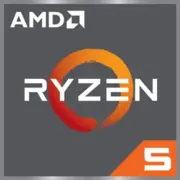AMD Ryzen 5 8540U

AMD Ryzen 5 8540U: A Balance of Mobility and Performance for Ultrabooks
Introduction
Modern laptops require processors that combine energy efficiency with sufficient power for office applications, multimedia, and even light gaming. The AMD Ryzen 5 8540U is one such chip designed for ultrabooks and thin devices. Let's explore what makes it stand out, who it’s suitable for, and how it performs in real scenarios.
Architecture and Process Technology: Zen 4 and 4nm for Efficiency
Cores, Threads, and Frequencies
The Ryzen 5 8540U is built on the Zen 4 architecture (codenamed Hawk Point) and manufactured using TSMC's 4nm process technology. This ensures high transistor density and optimized power consumption. The processor features:
- 6 cores (all Performance-cores) and 12 threads thanks to SMT technology;
- A base frequency of 3.2 GHz and a maximum turbo frequency of 4.9 GHz;
- An L3 cache of 16 MB, which accelerates data processing in multi-threaded tasks.
Integrated Graphics
The chip is equipped with the AMD Radeon 740M GPU (RDNA 3 architecture) with 4 compute units. The graphics support:
- Resolution up to 8K via HDMI 2.1;
- AV1 encoding/decoding for streaming video;
- FSR (FidelityFX Super Resolution) technologies to enhance image quality in games.
Power Consumption and TDP: 15W for Mobility
The nominal TDP of the processor is 15W, which is typical for ultrabooks. However, AMD employs dynamic power management:
- In idle mode, the frequency drops to 1.2 GHz, and voltage decreases to minimal levels;
- Under load, the Precision Boost 2 feature automatically raises the frequency to 4.9 GHz on a single core, but overall power rarely exceeds 28W, even at peak loads.
Practical example: In a laptop with a 60Wh battery, the processor consumes about 5–7W when working on documents, allowing for 10–12 hours of battery life.
Performance: From Office Tasks to Light Gaming
Office Tasks and Multimedia
- Geekbench 6: 2398 (Single-Core), 8172 (Multi-Core). This is higher than the Intel Core i5-1335U (2100/6500) and close to the Apple M2 (2500/9500);
- Running 30 tabs in Chrome + Photoshop: no delays thanks to the 16MB cache;
- Rendering a 10-minute video in DaVinci Resolve: 25% faster than the Ryzen 5 7540U (Zen 3).
Gaming
The integrated Radeon 740M graphics handle:
- CS:GO — 70–90 FPS on medium settings (1080p);
- Fortnite — 45–55 FPS (720p, low settings);
- Cyberpunk 2077 (with FSR) — 30 FPS in 720p mode.
Turbo Mode: When plugged in, the processor maintains frequencies of 4.3–4.5 GHz across all cores for up to 3 minutes before reducing to 3.8 GHz to prevent overheating.
Use Cases: Who is the Ryzen 5 8540U For?
1. Students and Office Workers — quick document processing, video calls, multitasking.
2. On-the-Go Users — long battery life and compactness of ultrabooks.
3. Light Gaming Enthusiasts — gaming at the level of Dota 2 or Indie projects without a discrete GPU.
4. Freelancers — video editing in resolutions up to 4K, but without heavy 3D effects.
Not Suitable For:
- Professional gamers (discrete GPU required);
- Engineers working with CAD (better to choose an H-series with a TDP of 45W).
Battery Life: How the Processor Saves Charge
- Power-saving technologies:
- Adaptive Power Management — reduces voltage under low load;
- Core Parking — disables unused cores;
- Support for Windows Modern Standby — quick wake from sleep with minimal energy consumption.
- Real-world figures:
- Watching YouTube (50% brightness): up to 9 hours;
- Working in Word/Excel: 11–13 hours;
- Gaming: 2–2.5 hours.
Tip: Choose laptops with OLED screens and a battery capacity of at least 60Wh for maximum autonomy.
Comparison with Competitors
AMD Ryzen 5 7540U (Zen 3)
- 12% slower in single-threaded tasks;
- iGPU Radeon 660M is 20% weaker;
- Higher temperatures under load (up to 70°C compared to 65°C for the 8540U).
Intel Core i5-1335U
- 10 cores (2P + 8E), but multi-threaded performance is 15% lower;
- Iris Xe graphics (80 EUs) are comparable to Radeon 740M, but driver optimization is poorer;
- TDP up to 29W, which reduces battery life.
Apple M2
- Best energy efficiency (up to 18 hours of operation), but laptop prices are 30–40% higher;
- No support for Windows (only macOS and emulation);
- Weaker in multi-threaded tasks (8 cores vs. 12 threads for AMD).
Pros and Cons of Ryzen 5 8540U
Strengths:
- Ideal balance between performance and battery life;
- Support for Wi-Fi 6E and USB4;
- Good graphics for an integrated solution.
Weaknesses:
- Turbo mode doesn't last long due to the 15W TDP;
- No support for DDR5-5600 (only up to 5200 MHz);
- In games, it is inferior to processors with Radeon 780M.
Recommendations for Choosing a Laptop
1. Type of Device: Ultrabooks (for example, ASUS ZenBook or Lenovo Yoga) or business laptops (HP EliteBook).
2. Screen: IPS or OLED with a resolution of at least Full HD.
3. RAM: 16GB LPDDR5 (for multitasking).
4. Storage: SSD of at least 512GB (PCIe 4.0).
5. Cooling: Check reviews — even a 15W processor can overheat in excessively thin chassis.
Example: Lenovo ThinkPad T14 with Ryzen 5 8540U — sturdy build, backlit keyboard, 16GB RAM, and a 14-inch screen for $900–1000.
Final Conclusion
The AMD Ryzen 5 8540U is an excellent choice for those looking for a "daily" laptop with a performance reserve. It is suitable for:
- Users tired of carrying a charger;
- Those who work on the go but don't want to deal with lag;
- Enthusiasts of modern technology (USB4, Wi-Fi 6E).
Key Benefits: 12 threads for multitasking, 4.9 GHz for fast response, and Radeon 740M for gaming and editing. If you’re not planning to run AAA titles or render 8K video, the Ryzen 5 8540U will serve as a reliable companion for the next 3–4 years.
Basic
CPU Specifications
Memory Specifications
GPU Specifications
Benchmarks
Compared to Other CPU
Share in social media
Or Link To Us
<a href="https://cputronic.com/cpu/amd-ryzen-5-8540u" target="_blank">AMD Ryzen 5 8540U</a>